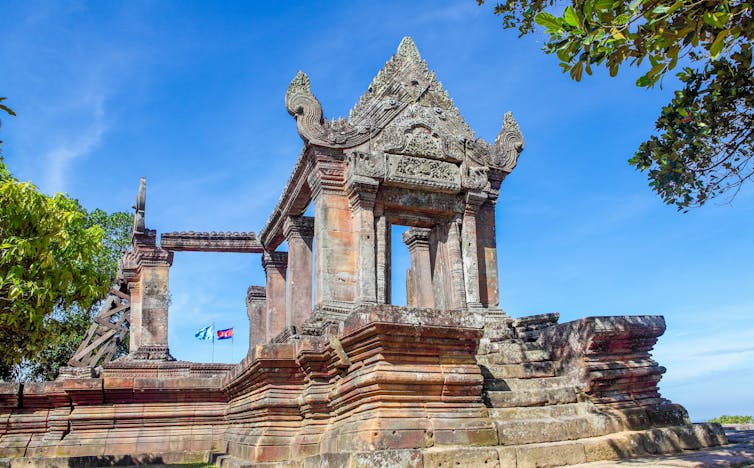Source: The Conversation – (in Spanish) – By Enrico Castroflorio, Neurocientífico especializado en función sináptica y lípidos, Universitat de les Illes Balears

¿Y si la clave para tratar el alzhéimer, la epilepsia o la depresión no estuviera en los genes o en las proteínas, sino en las grasas que recubren las neuronas?
Durante décadas, la investigación se ha centrado principalmente en estudiar las proteínas y genes defectuosos como la causa de enfermedades. A pesar de los avances científicos de los últimos años, aún no disponemos de tratamientos realmente efectivos para muchas patologías neurológicas.
Primeros resultados prometedores
La meliterapia (Membrane Lipid Therapy) es un nuevo campo de la biomedicina que busca tratar enfermedades modificando los lípidos de las membranas celulares del cerebro.
Los lípidos no son todos iguales: algunos, como los ácidos grasos poli-insaturados (entre ellos los famosos omega-3), pueden modificar la estructura de la membrana y, con ello, alterar la forma en que las proteínas se comportan. Esto significa que, ajustando el tipo de lípidos presentes en la membrana, podríamos recuperar funciones cerebrales alteradas en diversas enfermedades. Y los primeros resultados son prometedores.
Leer más:
Hay motivos para sospechar que el alzhéimer podría ser una enfermedad autoinmune
¿En qué consiste esta innovadora terapia?
Como apuntábamos, la meliterapia consiste en actuar sobre el entorno lipídico de las proteínas, la “alfombra” donde se apoyan, en lugar de atacarlas directamente. Al hacerlo, muchas proteínas podrían recuperar su forma y función originales. No es una terapia más: es un cambio de paradigma.
Ya se están desarrollando lípidos sintéticos capaces de integrarse en la membrana neuronal y modificar su organización. Uno de estos compuestos ha demostrado restaurar la función de proteínas alteradas en modelos experimentales de la enfermedad de Alzheimer], abriendo la posibilidad de recuperar circuitos neuronales dañados sin alterar el ADN ni manipular directamente el sistema nervioso con fármacos invasivos.
Pero ¿cómo se consigue? Debemos tener en cuenta que las membranas de las neuronas no son simples envolturas, sino estructuras dinámicas rebosantes de colesterol, fosfolípidos y ácidos grasos que influyen en la comunicación entre neuronas (sinapsis), la resistencia al estrés oxidativo, la supervivencia celular y en muchos otros aspectos clave para la vida de una célula.
Cuando estos lípidos se desequilibran, las neuronas funcionan mal y aparecen diversas enfermedades. La meliterapia busca corregir estos desequilibrios mediante cambios lipídicos o reajustes de la membrana plasmática de las células.
Leer más:
¿Y si el origen de la depresión no es como nos lo habían contado?
Experimentos exitosos
He aquí algunos ejemplos de la meliterapia en acción:
- Alzhéimer: recuperar las conexiones
En este trastorno, las neuronas pierden colesterol y ciertos fosfolípidos, lo que dificulta la formación de sinapsis, las conexiones fundamentales para la comunicación neuronal y, por lo tanto, para el funcionamiento del sistema nervioso. Un estudio reciente demostró que aumentar los niveles de omega-3 mejora la memoria en ratones.
Aún no hay resultados concluyentes en humanos, pero ya se están probando fármacos que estabilizan las membranas neuronales y podrían frenar el deterioro cognitivo que caracteriza a esta enfermedad.
- Epilepsia: equilibrar los lípidos para reducir los ataques
Al reparar las membranas neuronales dañadas, se podría reducir las crisis resistentes a medicamentos. Estudios muestran que ajustar los lípidos cerebrales con omega-3, como DHA y EPA, disminuye la hiperexcitabilidad neuronal, el estado en el que las neuronas se vuelven más propensas a generar impulsos eléctricos. Los ensayos en humanos son preliminares, pero la combinación con nanotecnología promete tratamientos más precisos. Este enfoque innovador podría complementar, e incluso sustituir, los tratamientos actuales en casos de epilepsia refractaria, donde los fármacos no funcionan.
Leer más:
Día del alzhéimer: El bilingüismo protege frente al deterioro cognitivo
.
- Glioblastoma: avances esperanzadores en la lucha contra el cáncer cerebral más agresivo
Un ensayo clínico acaba de arrojar resultados esperanzadores en torno a un fármaco basado en lípidos combinado con radio y quimioterapia para tratar el glioblastoma recién diagnosticado, que es uno de los tumores cerebrales más agresivos.
Los primeros datos apuntan a una mayor supervivencia de los pacientes, especialmente en aquellos con una característica genética llamada metilación del gen MGMT, que actúa como un mecánico que repara el ADN dañado. En la mayoría de los casos, resulta beneficioso, pero en el glioblastoma, puede ayudar al tumor a resistir la temozolomida. Este es uno de los tratamientos más usados para este tipo de cáncer y funciona dañando el ADN de las células tumorales. Si el MGMT está activo, las repara y la quimioterapia pierde efecto. Sin embargo, cuando el gen está metilado –es decir, desactivado–, el tumor no puede defenderse frente a los tratamientos.
En el estudio, el fármaco meliterapéutico fue bien tolerado y no se observaron nuevos efectos secundarios, lo que sugiere un posible beneficio para este grupo de pacientes.
Los retos de la meliterapia
Aunque este tratamiento suena muy prometedor, hay obstáculos que deberá sortear:
-
La barrera hematoencefálica: muchos lípidos pueden llegar al cerebro desde la sangre, pero algunos necesitan unirse a transportadores o vehículos especiales, como nanopartículas.
-
Efectos secundarios: para evitar efectos no deseados, es fundamental diseñar moléculas lipídicas que actúen de forma específica en el órgano o tejido que se quiere tratar, sin interferir con las funciones normales del resto del cuerpo.
-
Personalización: no todos los cerebros responden igual. Se necesitan terapias individualizadas para cada paciente.
Leer más:
CAR-T: así funciona la terapia que está revolucionando la lucha contra el cáncer
Una terapia revolucionaria
¿Y por qué esta terapia se presenta como un cambio de paradigma?
Porque nos invita a observar el cerebro desde otra mirada. En lugar de seguir buscando la “molécula mágica” que explique el origen de tantas patologías neurológicas, quizá debamos aceptar que la salud cerebral depende también de la armonía entre grasas y proteínas en un lugar tan aparentemente modesto como la membrana celular. Justo en ese límite entre el mundo exterior y el interior de la neurona, podría estar una de las llaves para entender y tratar algunos de los trastornos más complejos de nuestro tiempo.
![]()
Enrico Castroflorio no recibe salario, ni ejerce labores de consultoría, ni posee acciones, ni recibe financiación de ninguna compañía u organización que pueda obtener beneficio de este artículo, y ha declarado carecer de vínculos relevantes más allá del cargo académico citado.
– ref. Meliterapia: engrasar el cerebro para curar enfermedades neurológicas complejas – https://theconversation.com/meliterapia-engrasar-el-cerebro-para-curar-enfermedades-neurologicas-complejas-259581


